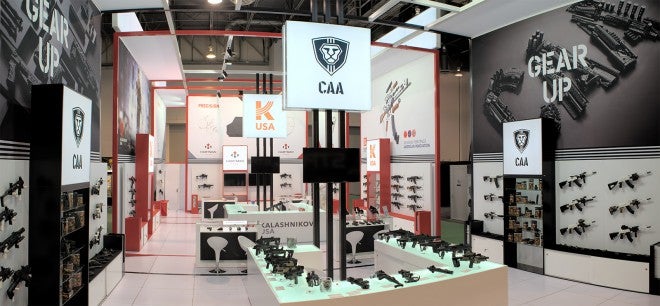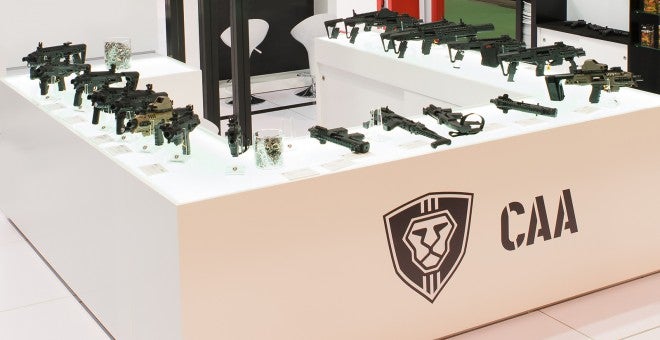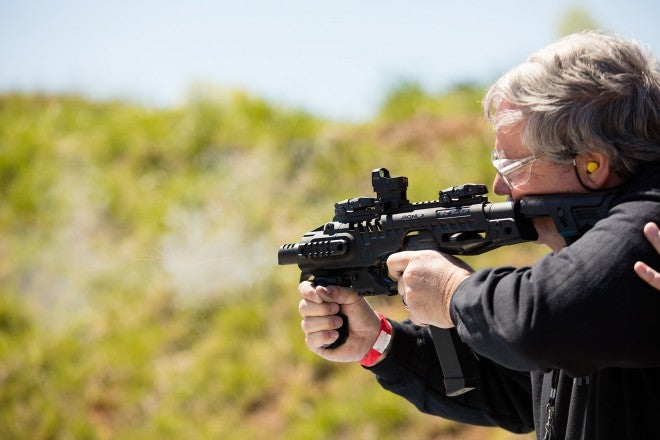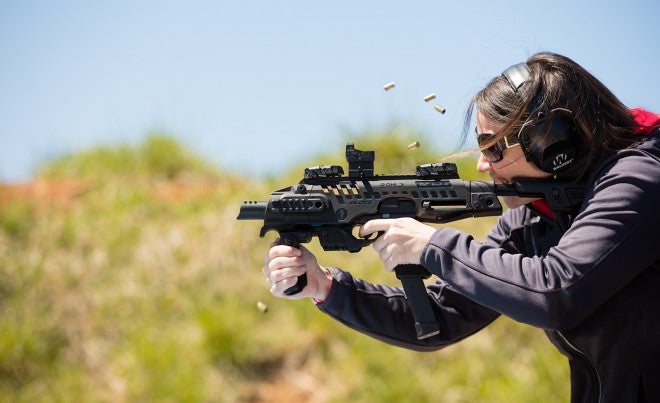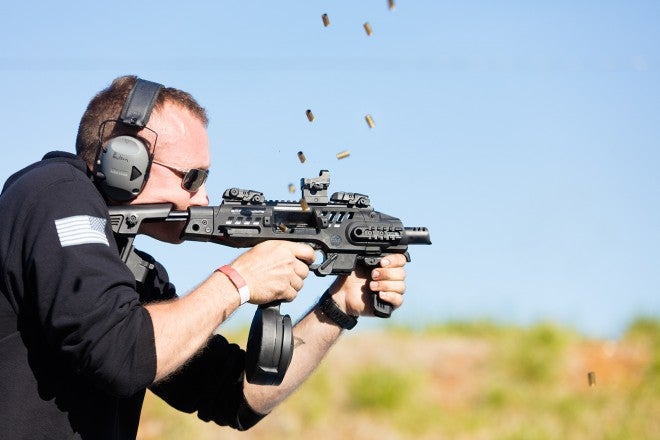CAA Roni Pistol Adapter
Oleg Volk 04.12.16

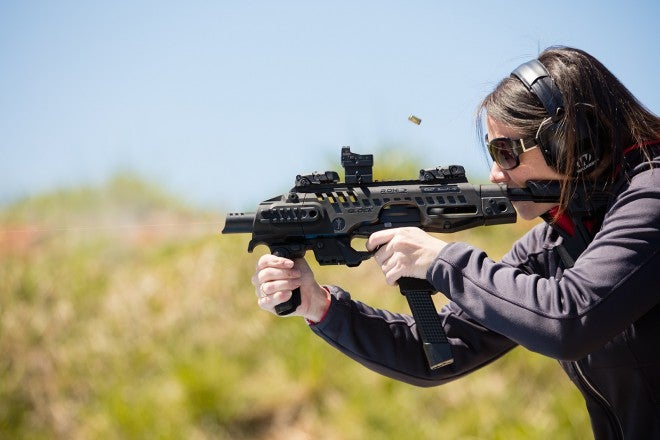
Command Arms Roni has been around for about six years. It’s a mostly plastic shell designed to snap around a handgun (see the caa roni manual for details) to provide greater control over the weapon. Since ATF considers the resulting firearm to be a short barreled rifle and requires a $200 tax stamp and registration, it’s been less than popular in the US. Its unique benefits have remained largely unknown to the US public.
Having walked past displays filled with a wide variety of Roni variants at trade shows, I was equally uninterested in it. I have plenty of pistol caliber carbines, so why should I bother with a heavily regulated conversion that costs as much as a mid-range complete weapon like Keltec Sub2000? Originally offered only for Glocks, Roni conversation for many brands and models of pistol are now available.
This year, the displays contained three types of Roni: the regular variant, the diminutive Mic-Roni, and the carbine designed around a 16″ Glock barrel. I handled them, appreciated the clever flag safety that covers the trigger from both sides, and put them back. Without live fire, the benefits of this design remained obscure to me.
While shoulder stocks for pistols go back at least to the 18th century flintlocks, it was Mauser C1896 that popularized the concept. Using a high velocity flat cartridge, that pistol benefitted from improved stability for long range shooting. While the wooden holster that attached to the back of the grip helped, it was only a stopgap solution on the way to true submachine guns.
As you can see, the ergonomics of the combination remain less than ideal. The hollow holster stock was also fairly fragile. This same approach has been tried with long-barreled Lugers, C712 machine pistol and its Spanish Astra clones, Browning Hi-Power and the Soviet APS machine pistol. All those suffered from relatively short sight radius and the lack of forend.
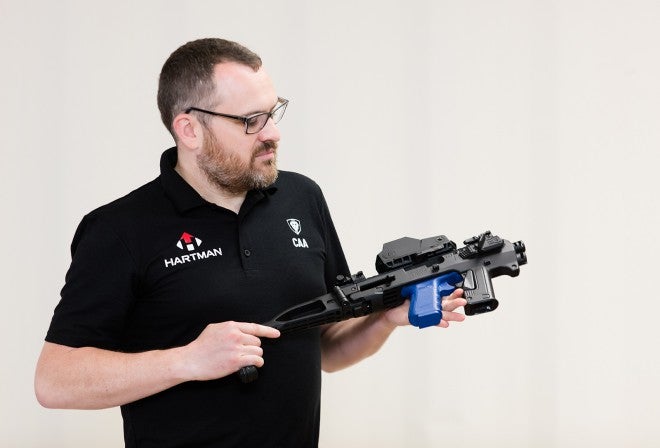
More recently, the concept was revived in Israel. As with many weapon-related inventions, it came from the restrictive laws that severely restricted the ability of Israeli citizens to own firearms. While it is possible to get a pistol license, almost no one in Israel, including retired army snipers and senior officers, is permitted to own a rifle. The weapons we see in the news are owned by the state and lend out to army reservists. Roni adapter was a legal way to have an almost-rifle in Israel. Last year, it made news in connection with terrorism prevention.
Last month, I got to handle all three models at Big 3 East Shooting Center. The Mic-Roni and the regular model both provided a great improvement in stability. For my eyes, at least, neither pushed out the front sight far enough forward to provide a good sight picture, but the 21st century has a fix for that problem: red dot sights. Using the excellent Hartman MH-1 red dot, I could easily hit silhouette targets at 150 yards. Without the conversion kit, 100 yards would have been my realistic limit and at much greater effort. With a shoulder stock and an optic not attached to a moving slide, I could ring steel as fast as I could point. Mic-Roni weighs exactly as much as an unloaded Glock 17: 710g. Put together and loaded with a 33-round magazine, they add up to 1.8kg–less than half of what an AR15 carbine in 9mm masses. The larger Roni adapter is twice the weight, which still only adds up to 2.3kg loaded.
The 16″ model Glock 17 based caught my attention the most. It provides much improved ballistics, reduces already negligible recoil to near zero, and offers an extended forend for steady holding. It weighs a little less than a 9mm AR while kicking a great deal less thanks to the locked breech design of the pistols used. Relative to the handgun, it is noticeably quieter. With the slightly flatter trajectory and much improved ergonomics, the carbine Roni–soon to be available for purchase–made 150 yard head shots a viable proposition. While few defensive situations call for such a feat, it does mean a greater confidence in making the same shot at ten yards than with a conventional pistol.
Roni may be fired safely from the left shoulder. The stock length is adjustable for different arm length and body armor. The safety and the charging handles are ambidextrous. It has plenty of rail space for lasers, lights, and other accessories. While its compensator is very effective, it’s not concussive.
What impressed me the most–enough to give this conversion a solid vote of approval for serious purposes–was just how controllable it makes the gun during rapid fire. Above is the standard Roni shell around a Glock 18 machine pistol that runs at 20 rounds per second. The smiling girl just fired an 8 to 10 shot burst, with five empties visible and several more behind her. She remains in control of the gun, and her group at ten yards was about the size of the A zone on an IPSC silhouette target.
The man above just fired at least a dozen shots, and his muzzle remains firmly on target as well. He can do four such bursts before his 50-round magazine runs dry, with each such helping of 9mm very likely to stop an opponent. Compared to older 9mm submachine guns, this is a spectacular level of control at greatly reduced bulk and weight. While we are reduced to post-1986 dealer samples when it comes to machine pistols, slightly lower rate of fire but with even greater control is available to the owners of semi-auto pistols combined with Roni conversions.
